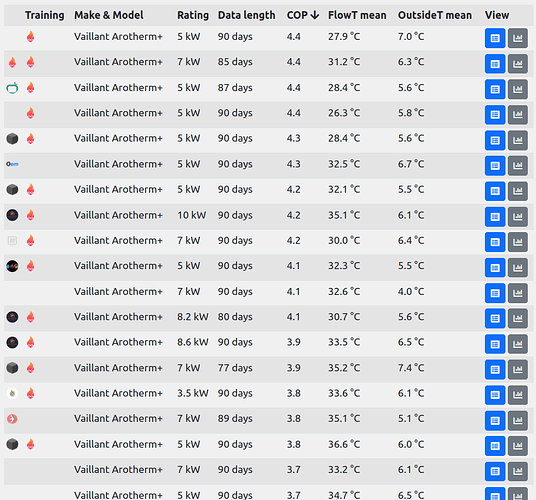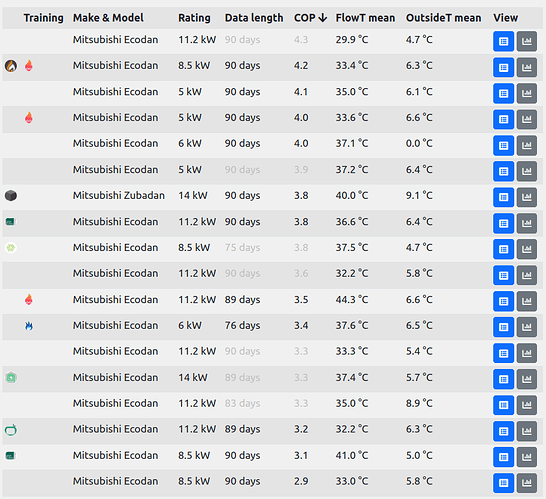Entirely new to this so please excuse any basic questions , in the fortunate position of being able to get an empty homes grant on top of govt £7k input to install solar and heat pump .
The installer has specified two Mitsubishi ecodan units but from the you tube videos I have watched by heat geek and urban plumber they seem to favour Vaillant , is this because they are all round better units or because they are similar but have better initial monitoring systems without having to pay for add on monitoring like Mitsubishi require ?
Hi Philip, welcome to the forum! ![]()
At HeatPumpMonitor.org you can see a bunch of systems from both manfacturers:
- Vaillant - 41 systems with an average 30 day COP of 4.1
- Mitsubishi - 22 systems with an average 30 day COP of 3.8
You may want to focus on properties that are similar to yours, so you get a rough picture of suitable models.
As you noted, the Valliants are favoured by Heat Geeks, and tend to perform better. Hard to say if this is because the heat pump itself is better made, or the heating system is better designed. Mitsubishi installs tend to be higher power units, though many of these may be oversized.
It’s really important to nail down the heat loss calculation for your property, as many installers will over estimate this and spec a heat pump that is bigger than you need. This will then mean less good performance in mild weather, i.e. all of spring and autumn. Get quotes from several installers…
Vaillant’s built-in monitoring might be better, but is not guaranteed to be accurate in all circumstances.
Thank you for reply .
I am also concerned about the possible oversizing , I think the installer may be as well , but they are working on a house that has a substantial mix of old and new , so some new flooring screed installed some not , some with bison beam , old gable end walls , other new or partial walls with block insulation and 1990s cavity wall insulation blown in and so on , there are too many variables hence I think the inclination to over specify .
My assumption is that if it’s over spec then it will be effectively inefficient and costly to run .
Thanks for info on data collection and other resources to look at , it seems paying for the separate data package would be necessary.
I would like to add that at least Vaillants implementation of their cycling method appears relatively immune to performance degradation. My pump is quite oversized and cycles essentially always but still hits the manufacturer specs on COP. What this does to heatpump longevity is a different discussion of course, but I’m seeing about one cycle per hour at max.
One way to test sizing is to do some analysis of your historic gas/oil (wherever you’re coming from) use. I would do this by getting a winter period over which you have good energy use info (easier if you’re on gas I know). Then find the number of degree days over that period (you can download quite local degree day data from Stark for free). Work out what your average kWh/degree day fuel use is over that period. (Probably use 15.5C base). Then determine what a worst case day is for your area and see what that tells you the total fuel use would be.
Then divide by 24 and you have an idea of what the rating of your heat pump ought to be.
Rachel
It’s interesting how close that is!
Is there any trend I wonder in performance at similar flow and outside temperatures?
Last 90 days, flowT and outsideT when running vs combined COP:
plotting these:
Take a look at the bits you see and touch - heating controls etc - and I suspect you’ll prefer the vaillant units.
Thanks , may I ask if yours is cycling as it is , is this increasing the running cost ? The bearing quality is presumably what will suffer most in your situation .
Unfortunately it was oil and I do not have the useage information, all I know is the original fifty odd year old boiler was replaced about ten years ago but made little difference to the oil consumption .
Running costs are quite good. No idea about costs not relating to electricity and impacted by cycling as the pump is only 4 months old. The larger Vaillant pumps (10 kW+) have an intrinsically higher COP than the smaller (<=7 kW) so that will also play a role.
Thanks, I had read about the higher COP for the larger units. I also understand Mitsubishi are using a new refrigerant , not sure what affect that has .
I think you’ll need to specify which Mitsubishi Ecodan you’re talking about as there seem to be models with different refrigerants.
Vaillant’s arotherm plus series use R290 (propane) which is a fairly “modern” since it has a low greenhouse potential and is a “natural” refrigerant (which gives you another 5% in subsidy when installing a heat pump with R290 in Germany).


